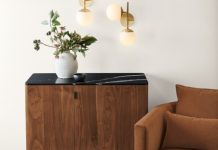
Above: A converted garage, designed by Christopher Strom.
Baby boomers want to age at home with the family. Twenty-somethings move back in with their parents to ease post-college financial strains. It seems more families are reverting back to the days of multigenerational living. And neither Grandpa nor Suzie is being jettisoned to the back bedroom.
Instead, homeowners nationwide are adding accessory dwelling units (ADUs)—also known as granny flats or secondary suites—on their property. Minneapolis is one of the latest cities to get on board. Last December, the city passed a zoning ordinance allowing ADUs on lots with owner-occupied single or two-family homes. Shortly thereafter, architect and entrepreneur Christopher Strom launched Second Suite, a design service offered by his eponymous firm that helps families pool resources and enjoy more quality time together. “ADUs are a nice way to establish multigenerational living next to the main house while giving the occupant an integral level of independence,” he says.
Secondary suites are frequently created within a portion of an existing garage or above it, complete with a small kitchen and bath. “The new Minneapolis law limits ADUs to a total of 1,000 square feet, including parking,” Strom explains. “Only one accessory building is allowed per property, so most people will combine an ADU with a detached garage.”
Strom also has designed ADUs that are fully functional, standalone structures. Whether in a style that complements or contrasts with the existing home, these are small living units that a young adult or grandparent can call their own. He also designs ADUs as art studios and home offices. “They’re a great entry point for people to start working with an architect,” he adds. —Camille LeFevre
By Camille LeFevre Photo courtesy of Christopher Strom
Designer: Christopher Strom




















